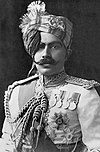Monarchy of Rajyaghar
| King of Rajyaghar | |
|---|---|
| Rajyaghar ke Maharaja | |
Federal | |
 | |
| Incumbent | |
 | |
| Krishan VII since April 10th 1984 | |
| Details | |
| Style | His Majesty |
| Heir apparent | Shivaji, Crown Prince |
| First monarch | Krishan VI |
| Formation | 17 October 1946 |
| Residence | Samrat Bhavan, Samudra Palace |
| Appointer | Hereditary |
The Monarchy of the Rajyaghar, is the constitutional monarchy of the Kingdom of Rajyaghar. The Monarchy is a hereditary institution with the the current monarch, Maharaja Krishan VII, belonging to the Rajana Dynasty; an ancient royal family which has historically ruled the Jhanda Empire, Sanyukti Raj, Naratha Confederacy, Sanyukti Empire and now the Kingdom of Rajyaghar and the Union State of Sanyukt. Prior to the end of the Solarian War when the Kingdom was still part of the Etrurian Colonial Empire, the Consular Senate called upon the Rajana Dynasty to lead the planned new constitutional monarchy upon the achievement of independence.
In modern Rajyaghar, the Monarchy plays an important functional role in the government and armed forces, as set out by the Constitution as well as through convention, precedent and tradition. Whilst most powers held by the monarch are exercised by the Government and Shahee Sansad, the Monarch retains significant reserve powers and continues to play an important influential role behind the scenes, settling political disputes, aiding the formation of coalition governments and weighing in on military and diplomatic operations. The Monarchy also plays an important role in the ashram faith in Rajyaghar, despite the faith being considered an 'unorganised religion'. The Monarch is tasked with appointing, at their discretion, the High Priest of Bishnupur who is the most senior ashram priest in the country. This has been a duty performed by the Dynasty's Patriarch since 1706.
Maharaja Krishan VII ascended the throne on the death of his mother, Maharani Shakti III, on 10 April 1984. On his accession, in accordance with the Constitution of the State of Sanyukt, his title of Prince of Sanyukt automatically transferred to his eldest son, Prince Shivaji, who also became heir apparent to the Rajyani throne, in accordance with the Constitution of the Kingdom.
History
Despite the Monarchy of Rajyaghar being only 75 years old, the Rajana Dynasty, the ruling house, is considered to be one of the oldest reigning royal families in the world. Its origins date back to 430 CE when Rajaram I of the Jhanda Dynasty formed the Jhanda Empire. In 800 CE, the Adhenata Kayud (transl. War of Subjugation) saw the Sangma subjugate the Jhanda Empire. The ruling Jhanda Dynasty were slaughtered by the Sangma during the looting of Kismat, the Empire's capital. Only Prince Prashant, aged 7 and distant nephew of the reigning Emperor, survived. Prashant was evacuated from the city by one of the Jhandan Generals; Sunder Sirasikar. Sirasikar would flee with the young Prince to Kinadica. From Kinadica, the young Prince would sign a treaty of suzreinaty with the Sangma, officially making the Empire a subsidiary state within the Sangma. Believing the Jhanda name to be cursed, Prashant would found a new Dynasty and Clan named after the Jhanda Empire's founder, Rajaram I; the Rajana Dynasty.
The signing of the treaty of suzreainity would mark the demise of the unified land and it would soon fracture into numerous states under the Sangma. Prashant's new Rajana Dynasty would consolidate the lands surrounding Kinadica to form Sanyukt in 802. In the 11th Century, numerous polities within the Sangma fractured away to form the Madhyarajyas (middle kingdoms), which occupied what is now modern-Rajyaghar. Amongst these was the Sanyukti Raj, led by the Rajana Dynasty, who would go onto lead the Raj, and later Empire, until the formation of the Naratha Confederacy in which the Rajana Emperors would serve as the Senpatis (military leaders) and later Chhtrapatis (Emperors).
Following the Euclean invasions and subsequent colonisation of Satria, the Rajana Dynasty would continue to lead the territory of Sanyukt as 'Princes of the Colonial State of Sanyukt within Satrian Etruriana. The Sanyukti lands that fell under the control of Gaullica would be lost to the Rajana Dynasty until independence when the lands would be reunited with the rest of Sanyukt through annexation. Colonial rule would continue until 1946 when the Sanyukti Prince, Krishan VI, was called upon by Rajyani independence leaders in the Consular Senate to lead the newly independent federal kingdom of Rajyaghar as Maharaja.
Duties and Responsibilities
Executive Role
Legislative Role
Judicial Role
Military Role
Religious Role
List of Monarchs
| Name | Portrait | Life span | Reign start | Reign end | Length of Reign | Official Titles |
|---|---|---|---|---|---|---|
(Aged 86) |
Sarvoch Rashak of Bishnupur "Mahatma Krishan, Bapu ke Raashtr" [1] | |||||
(Aged 60) |
Sarvoch Rashak of Bishnupur | |||||
(Aged 78) |
Sarvoch Rashak of Bishnupur | |||||
(Age 76) |
Sarvoch Rashak of Bishnupur |
Succession
Succession to the throne is strictly regualated by the Constitution of the Kingdom of Rajyaghar and through various subsequent Acts of Parliament. The Constitution lays out that the only descendants of Krishan VI may ascend to the throne of Rajyaghar. The first Act of Parliament to add restrictions on successsion to the throne was in 1942 when the Government introduced the "Succession Act of 1942" in which it limited ascension to the throne to followers of the faith of ashram. In 1956, Krishan VI asked the Shahee Sansad to amend the Constitution to allow the ascension of female descendants to the throne, which had previously been prohibited. The Amendment was passed by the Shahee Sansad and signed into effect as a Royal Decree in 1957, bypassing a national referendum[2].
Upon the death of the Monarch the heir to the throne immediately becomes the new Monarch, hence the phrase "The Maharaja is Dead! Long live the Maharaja!". The ascenscion of the new monarch is formally announced by the Pramukh Shasandhikaree (Lord Chancellor)to the Ascension Council which meets at the Royal Palace of Kinadica. In Kinadica, the Governor announces the death of the monarch and ascension of the new monarch outside the main gates to Samudra Palace.
Upon their ascension, the new monarch is required to sign and take several oaths: the Ascension Declaration stating their willingness to ascend to the throne; an Oath of Dedication to the Constitution reaffirming their duty to protect the principles of the Constitution; and an oath that they will "maintain and preserve" the ashram faith as well as the "culture and society of Rajyaghar". As the Constitution derives its power from the Monarch, the new monarch does not swear an oath of allegiance to the constitution but rather swears an oath that they will defend the basic principles and spirit of the Constitution. In Rajyaghar, no oath of allegiance to the constitution is sworn, all oaths of office and allegiance are to the Monarch. Upon the death of a monarch, the heir apparent automatically becomes Monarch and their titles of Crown Prince and Prince of Sanyukt automatically go to their heir apparent.
Upon the death of a monarch, there is a period of mourning of 11 days with the cremation of the late monarch occuring on the 11th day. The cremation takes place at Memorial Arch on the Rajpath on Government Hill. The deceased is laid on a marble plinth under the roof of the Arch between the four columns. The new monarch will then light the plinth from the gap between the two north facing columns of Memorial Arch. In 2010, Memorial Arch was rennovated to house hundreds of discreet and small extractor fans so that the ashes can be collected. This was in line with Maharaja Krishan VII's wishes so that he could be cremated at Memorial Arch but then his ashes be spread over the Naratha River.
Crown Prince
The title given to the heir apparent/presumptive to the throne is Crown Prince. The heir apparent/presumptive is automatically afforded the title. Due to the heir serving as Prince of Sanyukt, their full title is: His/Her Royal Highness the Prince(ss) [name], Crown Prince(ss), Rajakumar of the Union State of Sanyukt. They are commonly referred to as HRH the Crown Prince(ss), or HRH the Prince of Sanyukt when in the Union State of Sanyukt.
There are several duties prescribed to the heir to the throne by the Constitution of Rajyaghar and Constitution of the Union State of Sanyukt:
- Presiding over the Council of States[3]
- Aiding and assisting the Monarch in their duties
- Serving as Prince of the Union State of Sanyukt[4]
Regency
Residences and Finances
Arms and Styles
Notes
- ↑ Title given posthumously
- ↑ "Crown and Parliament move against public opinion to include women in the line of succeession" Times of Satria, 1957 - Article outlines how both King and Parliament moved to bypass a public referendum which would have likely been voted down, embarassing Crown and Parliament
- ↑ "Standing Orders of the Council of States" - Day to day presiding duties are exercised by the Adyaksh of the Council
- ↑ "Constitution of the Union State of Sanyukt" - Sanyukti Constitution automatically transfers the title to the heir apparent of Rajyaghar





